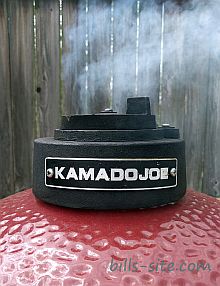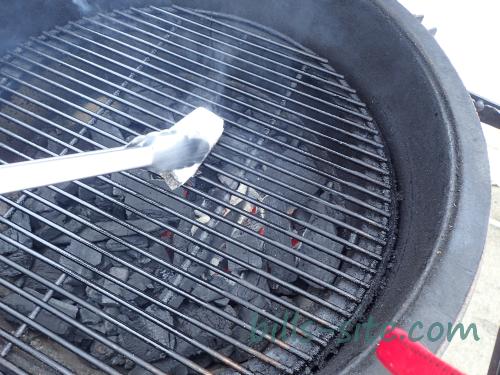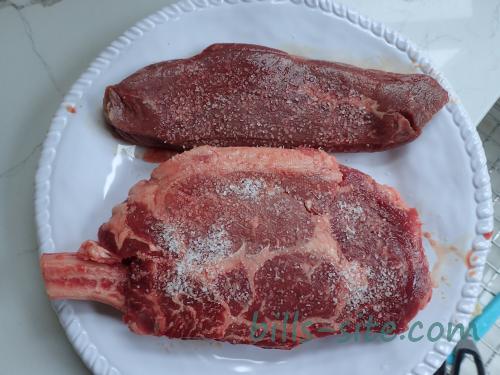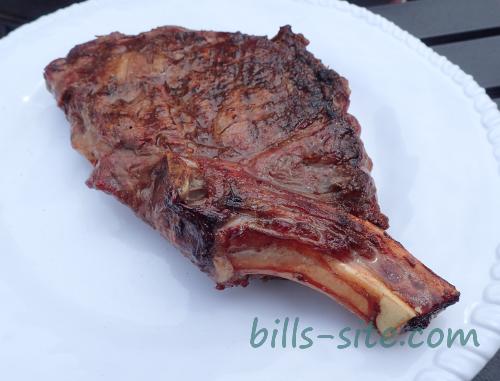 Today we’re looking at the best way to grill a ribeye steak.
Today we’re looking at the best way to grill a ribeye steak.
We have several in the freezer, so today, I pulled one out for me and one New York strip steak for Midge.
Cooking a ribeye on the grill makes for some seriously good eats.
Just what is the best way to grill a ribeye steak?
So let’s get started and find out …
The Best Way to Grill a Ribeye Steak
We have talked about cuts of beef here before, so we’re not going into that again. Here, we really like the ribeye. However, a bone-in ribeye is even better. Of course, a big ole’ tomahawk ribeye is the best. But we have a hard time finding those.
So the ribeye we have today is just under one inch thick, and we’re aiming for a nice medium rare. A 1-inch ribeye is what most of us have easy access to at our local grocer. As such, we needed no special request at the meat counter. Also, a 1-inch ribeye steak is easier to grill!
Tools and Supplies
Firstly, a quality instant-read thermometer is a must to get that perfect cook.
We’re using our trusty ThermoWorks ThermoPop instant-read thermometer today. You can read our ThermoPop instant-read thermometer review here. Or you can check out the ThermoPop here on the ThermoWorks website.
Secondly, you always need good barbecue towels for grilling tasks. Check out our barbecue towel review here.
Lastly, you’ll also need a way to time the cook for the perfect grilled ribeye.
Setting Up the Grill
The best way to grill a ribeye steak on the grill, or anything else, is doing things the same way each time for a repeatable process and a great grilling experience.
Naturally, we’re cooking over direct heat. The first step is to preheat and stabilize our grill. We’re aiming for a dome temperature of 400 °F / 205 °C. From experience, I know that the grate temperature will run closer to 450 °F / 232 °C. So, it might take up to an hour to stabilize your Kamado Joe at operating temperature.

Clean and oil the hot grill grates. Oiling hot grill grates will help create a non-stick finish similar to your cast iron cookware. So we start by dipping a paper towel into a small bowl of cooking oil and rubbing it over the cleaned grates with our grill tongs. Use caution. You don’t want an oil-saturated and dripping paper towel creating flare-ups as you go. A light coat is best. I’ll repeat this process a dozen times, letting the heat create the seasoned cook surface.
Preparing the Ribeye
While the grill is preheating, remove the ribeye from the refrigerator and let them warm to room temperature. A room-temperature ribeye steak will cook faster than a cold one straight from the fridge. Less cooking time means less time to dry out. A cold ribeye steak will contract more when you put it on the hot grill and squeeze out more juices.
The Best Seasoning for Ribeye Steak on the Grill
So nothing too fancy. Salt enhances the positive sensory attributes of foods and makes things taste better.
Furthermore, those high-dollar steak houses don’t use fancy spice blends, nor are we. Therefore, we want to avoid masking that natural beefy ribeye flavor. Most importantly, we what to enhance those natural beefy flavors.
Give each side of the ribeye a liberal coat of kosher salt. Sprinkle generously from above for an even coating.

The Perfect Grilled Ribeye
Flip the ribeye steaks and grill until they are 10 °F / 5 °C below the desired temperature. If needed, pull the ribeye to a cooler part of the grill and away from the direct radiant heat.
To measure the internal ribeye temperature with an instant-read thermometer, insert the temperature probe into the center mass of the ribeye steak.

Remove the ribeye steaks from the grill to a serving platter and allow time for carry-over cooking, taking the steak to a perfect 125 °F / 52 °C.
Steak Temperature Guide
Cool red center, rare: 120° to 125 °F / 49° to 51 °C
Warm red center, medium rare: 125° to 135 °F / 55° to 57 °C
Warm pink center, medium: 135° to 145 °F / 60° to 63 °C
Slightly pink center, medium well: 145° to 155 °F 65° to 69 °C
Little or no pink center, well done: 155 °F+ / 71 °C+
Maillard Reaction
The Maillard reaction is a chemical reaction that gives grilled food its distinctive flavor and aroma.
The Maillard reaction involves the amino acids found in meat when cooked between 280 to 330 °F / 140 to 165 °C. It happens by many simultaneous chemical reactions when proteins and sugars in and on your food are exposed to heat and produce new flavors, aromas, and colors.
Check out my other Kamado Joe and JoeTisserie recipes and links here on my Outdoor Eats page.
